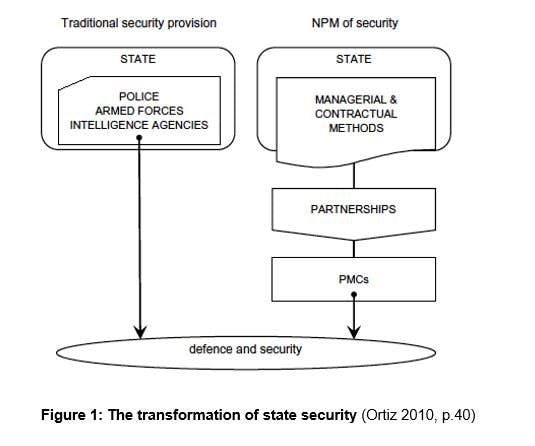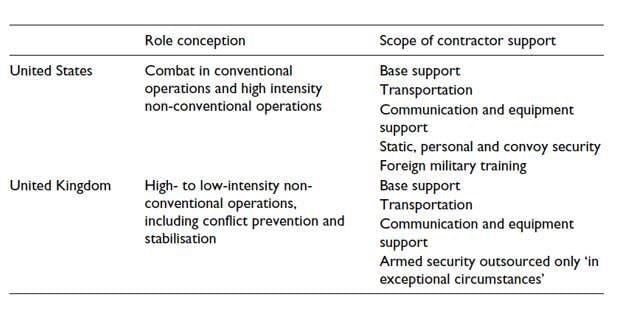by John J Hesketh.
Introduction
In the modern age, the provision of national security has been seen as a state responsibility and overwhelmingly as a state function, both in Britain and globally. During the World Wars and subsequently the Cold War, the expenditure and coordination to ensure national survival could only be achieved by the nation itself – although this came at an extraordinary price. When this period of assured defence requirements came to an end in the 1990s, governments worldwide seized the opportunity to radically downsize their militaries, typically by around a third (Heinecken 2014). Conflict and instability continued, although generally on a small scale, usually unpredictably and geographically disparate from the homeland security that twentieth century military strategy was largely based around.
Today, the UK government needs to continue to make provision for national security whilst operating within stringent fiscal boundaries – along with the social and welfare needs of the population. It is therefore unsurprising that the spotlight of efficiency was, and remains, pointed squarely at the MOD, an organisation that struggles to demonstrate cost-effectiveness in a field where there are few tangible benefits to the majority of taxpayers. Outsourcing offers governments the opportunity to “buy” services from the market, instead of the traditional “make” route – and theoretically increase efficiency and performance simultaneously. This report will consider the advantages and disadvantages of the MOD’s propensity to outsource and assess whether continued expansion of the practice should continue.
Outsourcing: a growing trend
“The outsourcing of military support has gained momentum due to the emerging belief in the superiority of market solutions and the neoliberal commitment to reduce the size and functions of the public sector.” (Cusumano 2015, p.220)
Devolution of military support functions is not a new phenomenon – in the UK, the MOD’s competitive procurement policy (encompassing equipment and support functions) was introduced in 1983 by the Conservative government with the aim of improving efficiency and achieving VfM (Hartley 2011). Public sector activities, regardless of department, are state monopolies – with no (threat of) competition there is little incentive to innovate, or to improve efficiency or quality, making eventual private sector involvement almost inevitable in an attempt to combat this. A political and national appetite to support outsourcing must exist (although the NHS is an example where it does not) and there are limits to private involvement, including front-line combat, biological and chemical defence and nuclear deterrence. As time goes on these limits are likely to be challenged (which will be discussed later) but already the extent of contracted support has reached unprecedented levels and is developing beyond traditional support services.
Figure 1 illustrates the traditional route for state security provision and the developing NPM framework for increasing involvement of the private sector – as embarked on by the UK.
Military outsourcing has developed through two stages, as described by Heinecken (2014): the single client phase, where the military is one of a portfolio of clients serviced by a company; and the main client phase, where the military is the principal or sole consumer of a firm’s services. The latter is increasingly common and represents an interdependence between the state and a limited number of large companies – and a potential threat to the efficiencies being sought. Long-term PPPs often fall in this category and five of the six categories initially identified by the UK government in 1996 are service-based (Hartley 2011).
Risks
A principal benefit of outsourcing is increased efficiency, but defining the required level of efficiency is the first challenge before any contract is signed. Achieving the perfect balance between technical efficiency (the maximum possible output for the price) and allocative efficiency (the combination of outputs which best accords with consumers’ demands) (Nellis and Parker 2006) is virtually impossible, particularly in a changing world. There is little doubt that pure technical efficiency has a place in some basic defence services but even here the least-cost option might not always be the best. As complexity increases, difficult judgements on the level of defence expenditure against the promised output must be made.
These decisions which will have lasting effects and require inputs from commercial staff and, frequently, the military end-user (who may not remain in post long enough to see the contract commence!). Achieving a cost/service equilibrium that satisfies all defence stakeholders and can remain relevant throughout the life of a contract is probably the greatest challenge of outsourcing, particularly in view of the media scrutiny that often surrounds public expenditure decisions.
Governments seeking to justify outsourcing cannot escape the classic principal-agent problem: service providers are ultimately driven by the requirement to maximise profit for their shareholders (Markusen 2003). There is an incentive for contracted firms to deliver the terms of their contract at the minimum cost; although getting this wrong risks reputational damage which might jeopardise future business, the true cost might be in reduced defence capability. For long-term PFI contracts, negotiations rely on parties acting in “good faith” (Parker and Hartley 2003) – something very difficult to enforce. Defence must recognise the possibility that private markets can fail and that bids for contracts may be so low that they fail to cover costs, often referred to as the “winner’s curse” (MacDonald 2010), as happened to the East Coast Main Line railway franchise (BBC News 2009). This situation prompted nationalisation of the line when a renegotiation request by the franchisee was refused by the government; in a defence context, there may be no option but to re-open talks with a provider, depending on the nature of the service. Such levels of reliance on outsourcing is a related but separate risk, and may lead to price increases over time if the specialisation is one that cannot be adequately substituted (e.g. pilot training or specialist engineering).
Outsourcing has undoubtedly grown, in part, due to defence rationalisation and a draw-down in capabilities – where organic capabilities and market transaction costs are low, the “buy” decision is straightforward (and vice-versa), as described in Figure 2.
Figure 2: The make or buy decision: transaction costs versus organic capabilities. (Adapted from Parker and Hartley 2003, p.100)
When fiscal pressures demand a commercial solution in a novel, complex area, transaction costs increase exponentially with no guarantee of a successful outcome. The UKMFTS partnership with Ascent is an example of how difficult it can be to write, monitor and enforce contracts of large scale and scope (Morse 2015). Petersohn (2006a) points out that, although the US military saved US$700m via low-skill, repetitive task outsourcing, more complex tasks actually cost more when privatised. Whereas this represents a financial risk, a less tangible issue is the dilution of contemporary military experience that outsourcing can bring about (such as permanent contractors in training delivery roles) together with the lure of civilian terms and conditions to serving personnel (Heinecken 2014).
Benefits
The essence of NPM is that the government shifts from being the provider of its own services to the arbiter of services provided by others (Bevir, Rhodes and Weller 2003): outsourcing addresses the problem of the state monopoly, even if the provider is only compared with the previous public sector service. The efficiency that outsourcing can provide is the obvious benefit in any argument – cost savings of 20-25% in non-deployed service provision is possible when exposed to competition (Uttley 2006). Although such potential gains rely partly on neoclassical assumptions of perfect competition that are normally impossible to achieve inside the regulated realm of defence, the motivation of profit is likely to drive efficiency to some extent. Transferring manpower to the private sector allows prioritisation of uniformed resources; cynically, the armed forces can exceed their manpower limits by outsourcing, but there are probably few soldiers who complain about mundane tasks being privatised. Other manpower benefits include reductions in personnel, pension and housing costs.
Involving the private sector opens up defence to advances in technology and innovation that simply would not occur without the private sector. Not only can this bring immediate benefits in financial capability, exposure of military personnel to contemporary business techniques will allow such practices to permeate the wider defence organisation. In turn, the private sector can bring wider societal benefits through export activity, if security restrictions allow. A good example of all these benefits is the privatisation of elements of the Defence Evaluation and Research Agency in 2002, with the new private company (QinetiQ) providing specialist test and evaluation services to defence whilst developing into an international defence firm (Bourn 2007). The increasing use of technology in warfare has forced the outsourcing of some specialist high-technology skills that cannot be realistically maintained “in-house”, sometimes delivered in operational theatres as part of a maintenance agreement; the MOD has developed an overarching CONDO policy to harmonise such support requirements (Uttley 2004).
Outsourcing of service provision via PFIs has allowed levels of capital investment in defence that probably would not have happened otherwise: this is the reality of reduced defence spending and the alternative is the “equal misery” option, such as programme delays or training rationalisation (Hartley 2004). Large PFIs, such as the AirTanker partnership to provide air-to-air refuelling, can plug capability shortfalls as older equipment becomes obsolete. Where such large sums are being invested, employment of the private sector allows a proportion of the risk associated with major programmes to be divested to the contractor; this is true with any outsourcing scheme, although the ultimate risk will always lie with the government.
US outsourcing
The expeditionary nature of post-Cold War conflict has led to most Western militaries adopting outsourcing to a greater or lesser extent, chiefly in logistics, equipment support, security and training. There is a marked difference between the US and UK militaries, where the latter has refrained from outsourcing armed security and the provision of foreign military training (Cusumano 2015) – see Figure 3.
Figure 3: Military role conceptions and contractor support in the United States and the United Kingdom (Cusumano 2015, p.230)
The differences in civil/military culture in the USA, when compared to the UK and other European nations, goes part way towards explaining why deployed contractor support has been embraced as it has. Ever since the Second Amendment to the US Constitution, the concept of the “citizen-soldier” has developed (Krebs 2009), reinforced recently by significant contributions in Iraq and Afghanistan by reserve forces and the National Guard. Graduation of outsourcing to armed security (which is seen as logistical support in the US) and beyond is a natural progression and does not attract significant public resistance. The US notion of the purpose of its armed forces is different to that of the UK, where the political impact of deployed forces can be far more important than the military effect achieved – it is important that these small, expeditionary forces are self-sufficient. Although the US has suffered reputational damage from using PMSCs (such as the Blackwater killings in 2007 (Dunsmuir 2015)), the Bush administration’s committal in 2002 to the privatisation of all activities not directly linked to war fighting (Cusumano 2015) seems unlikely to be reversed. Indeed, during the introduction of the Predator unmanned air vehice, the US Air Force even used contracted pilots in order to deploy the system earlier than would otherwise have been available (Petersohn 2010a), although the aircraft were in an unarmed role.
Contractual Combat
The financial pressure applied by successive CSRs and SDSRs looks set to persist and, as a result, ways to increase efficiency will continue to be sought. Although the “red line” of private soldiers acting for the state remains some way from being crossed in the UK, it is being approached. In the first Gulf War, deployed civilian contractors amounted to 1 in 60 uniformed personnel, but by 2006 in Iraq the ratio was 1.5 contractors to each military member (Uttley 2006). Defence NPM demands that the government “thinks the unthinkable”; the reliance on civilian support in Afghanistan is probably little-known by the public, but shows how far outsourcing has come. The benefits discussed so far would apply to outsourced combat forces, together with others including a huge reduction in the training burden which, as a bottom-fed organisation, costs the military so much. The flexibility offered by PMSCs cannot be matched by the government, particularly in terms of manpower and materiel resources; the challenges of integration and cooperation with regular forces would be vast but not insurmountable. Whether the image of the armed forces being diluted by contracted combat personnel would be publically acceptable is another matter, particularly in the UK where reputational military standards are so high. Nevertheless, use of PMSCs to protect UK-flagged merchant ships in the Gulf of Aden is evidence of progress (although not contracted directly by the government).
The potential pitfalls are legion, however. Transaction costs might be astronomical, particularly those associated with defining the allocation of risk – though the state would retain ultimate responsibility in any overt operation. Command and control of contracted forces would require definition and could be straightforward enough until the situation changes (as it inevitably does in combat), leading to potential lack of flexibility and the possibility that contractors might simply leave if the situation worsens. Would contractors in direct support of combat be acting in the interests of the state, or the shareholders? Holding companies to account when things go wrong would be very difficult and would only be good news for lawyers; the injury or death of a civilian at the hands of a PMSC might jeopardise a mission or even a whole campaign due to the resulting loss of legitimacy (Petersohn 2010b).
Conclusions
The global security situation and nature of military interventions since the end of the Cold War has seen a trend towards greater outsourcing in defence, driven in part by the wider adoption of NPM by Western governments. Principal risks involved with outsourcing defence services include reduced flexibility, accountability and loyalty of private firms, together with increased transactional costs as service complexity rises and the diminution of the reputation, and potentially standards, of the armed forces. These risks must be balanced against the advantages of innovation, increased efficiency, external expertise, investment and risk transfer that the private sector can deliver. Outsourcing is not suitable for every defence function, although the experience of US outsourcing (where, for instance, armed security on foreign soil is seen as a logistical support function) demonstrates there are areas for development that have not yet been explored by the MOD. Outsourcing by the UK in deployed operations developed throughout the Iraq and Afghanistan engagements and, however unpalatable it may be to soldiers and the public, future operations will not be possible without the service support that contractors provide. Domestic outsourced services will continue to develop in the UK and are certainly here to stay; going beyond outsourced indirect combat support services may be some way off, and the potential benefits of doing so are apparently outweighed by the likely dangers. However, it should be noted that the UK is not a signatory of the 1989 UN Convention against the recruitment, use, financing and training of mercenaries (Percy 2006) and the route to contracted combat remains, in theory at least, open.



No comments:
Post a Comment